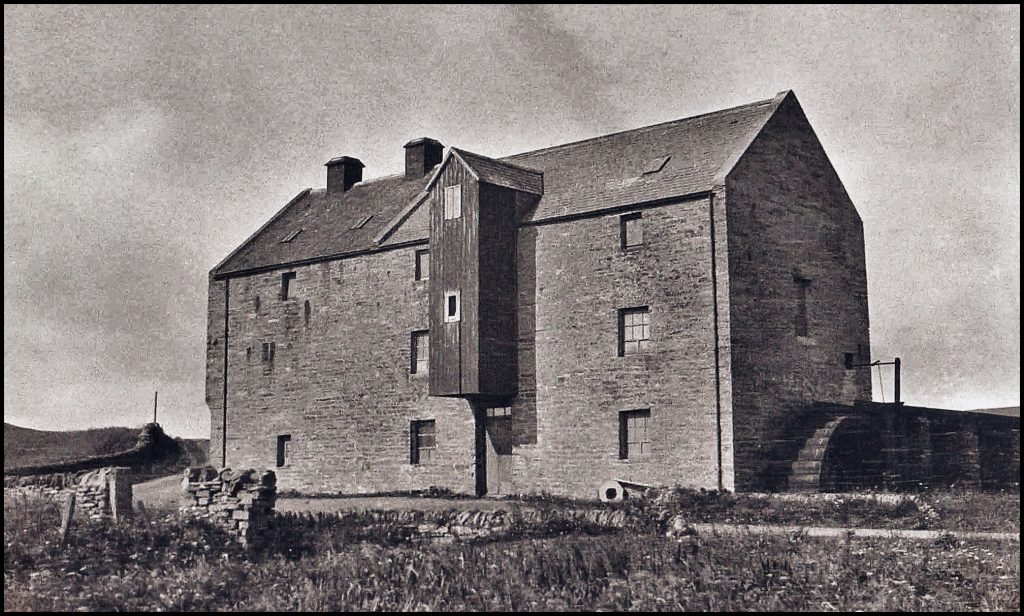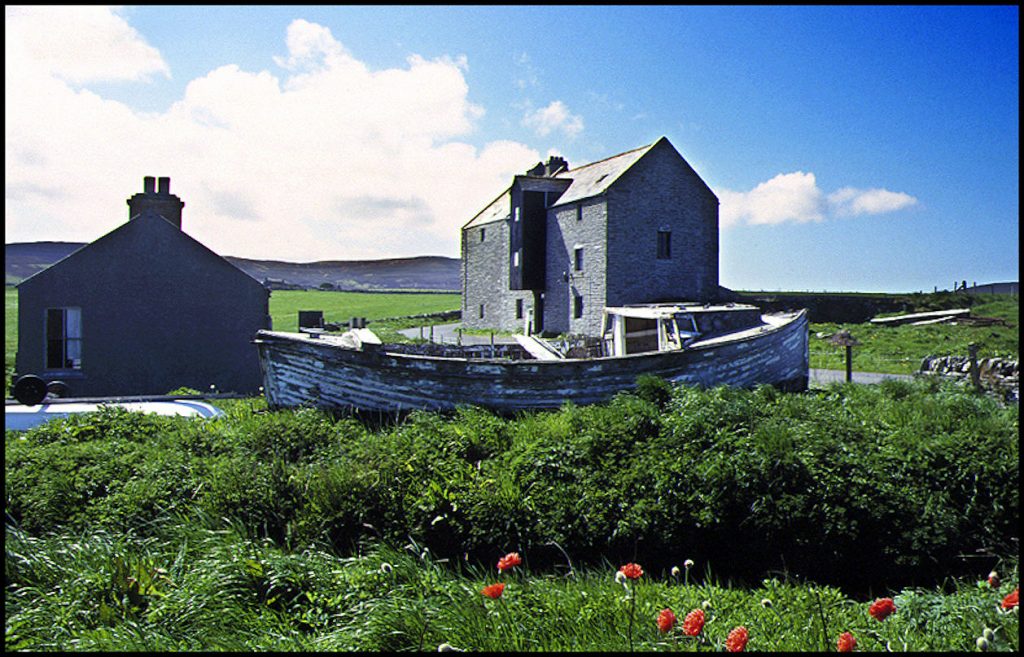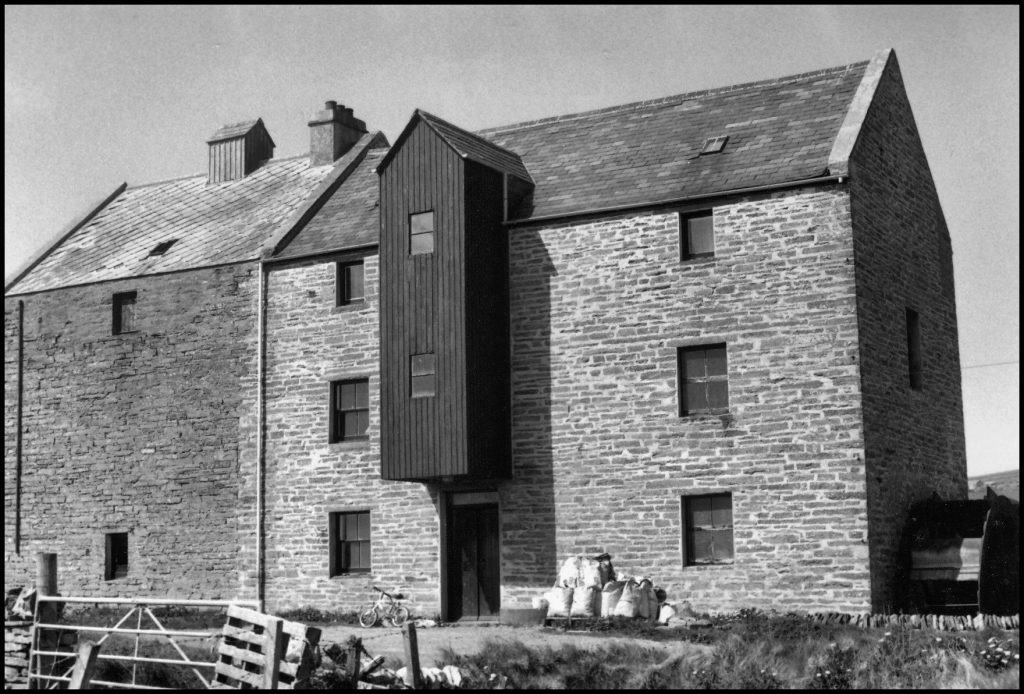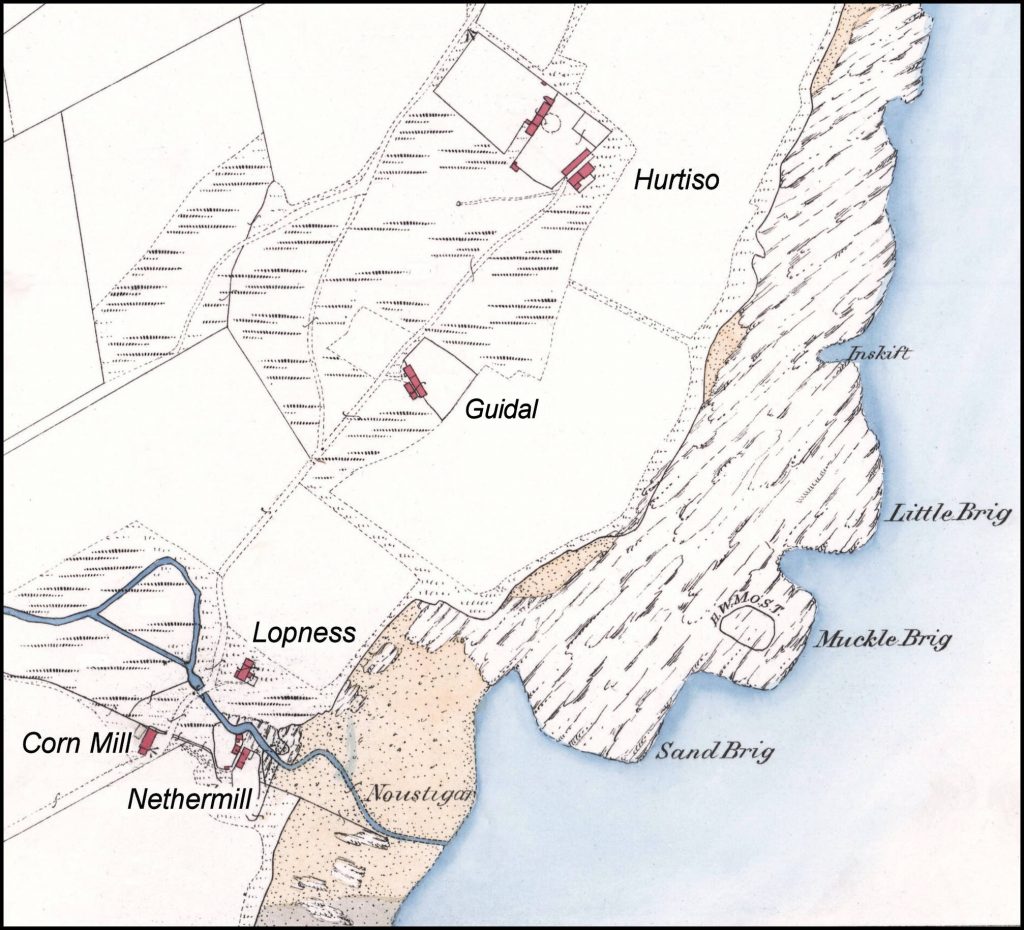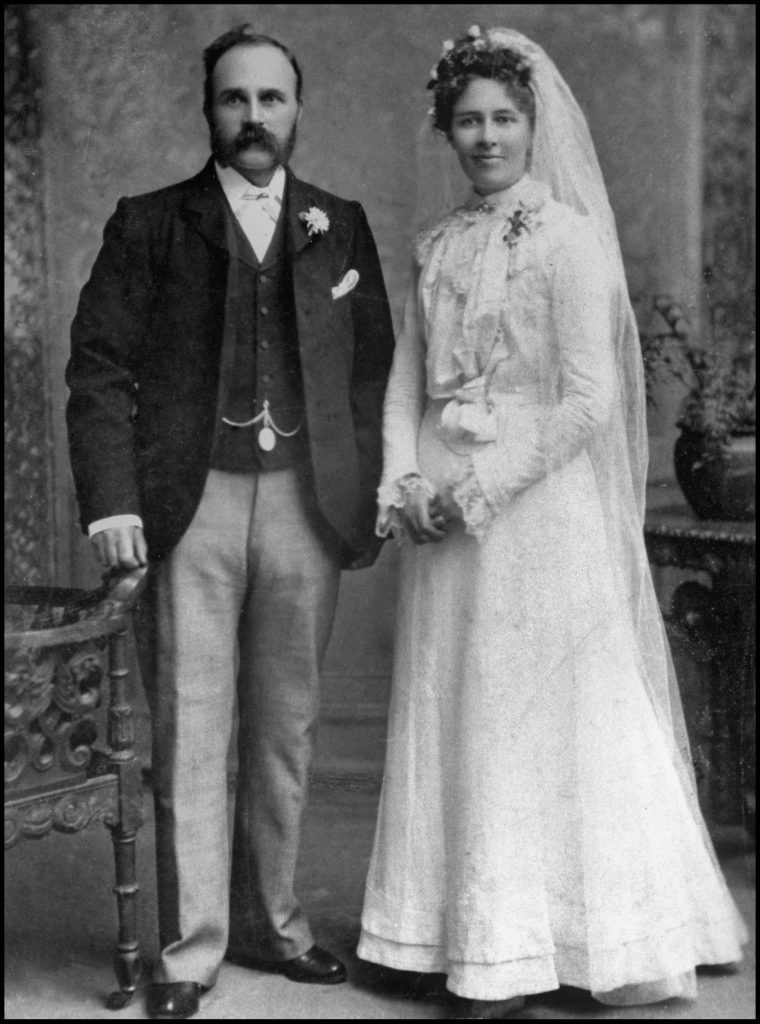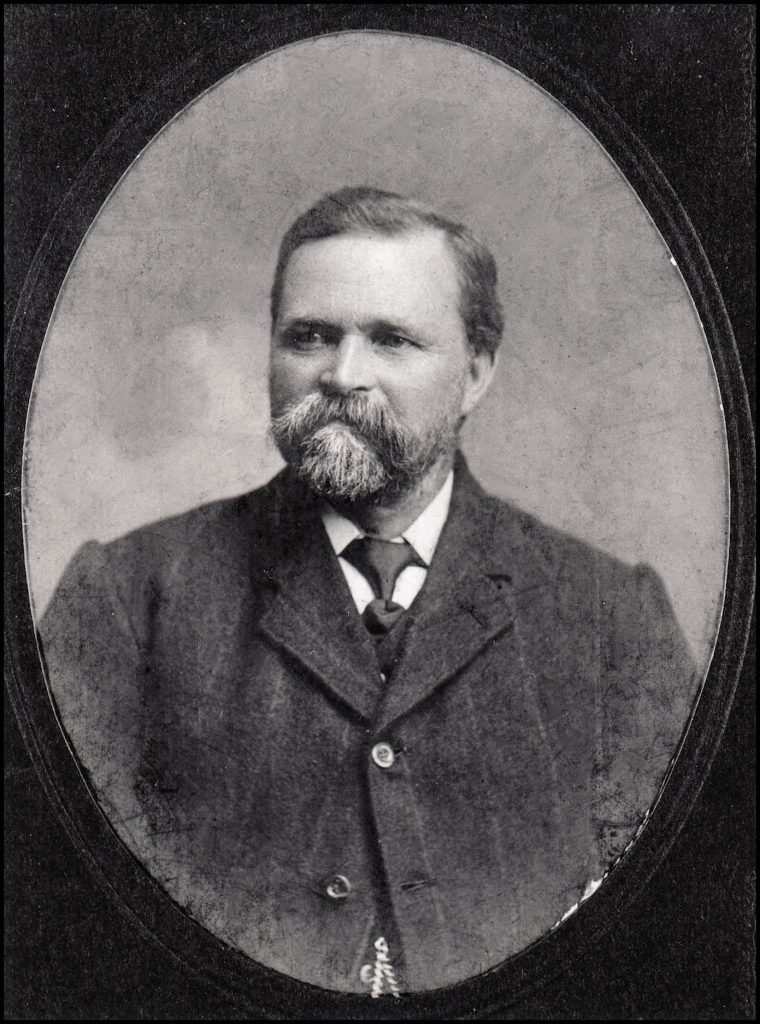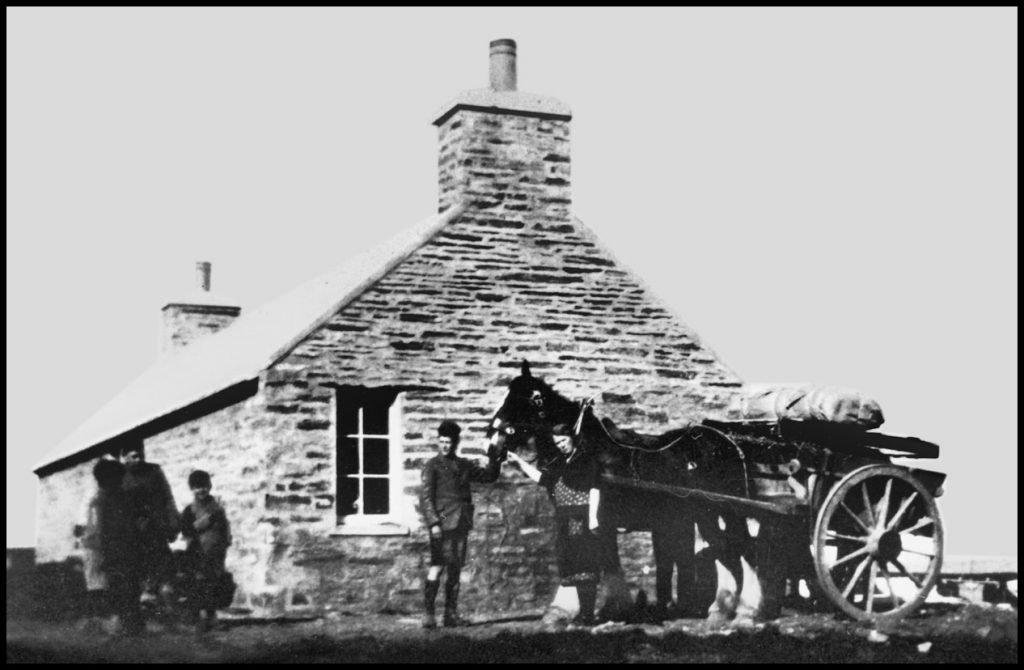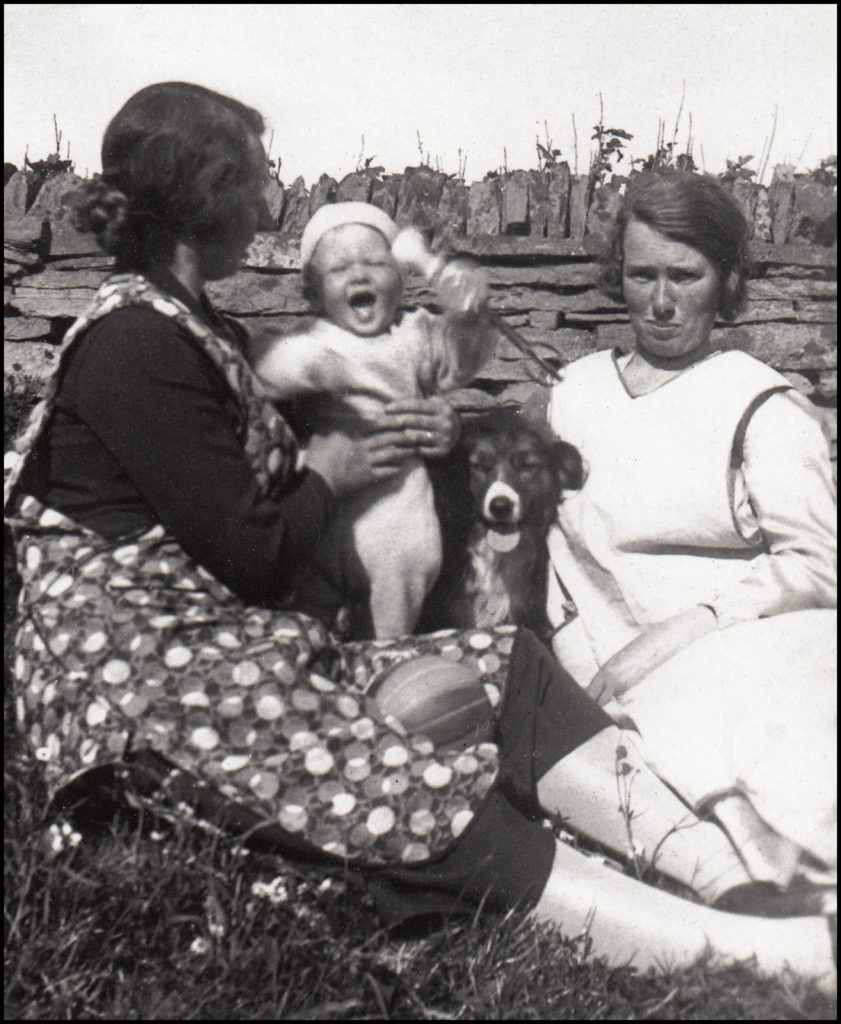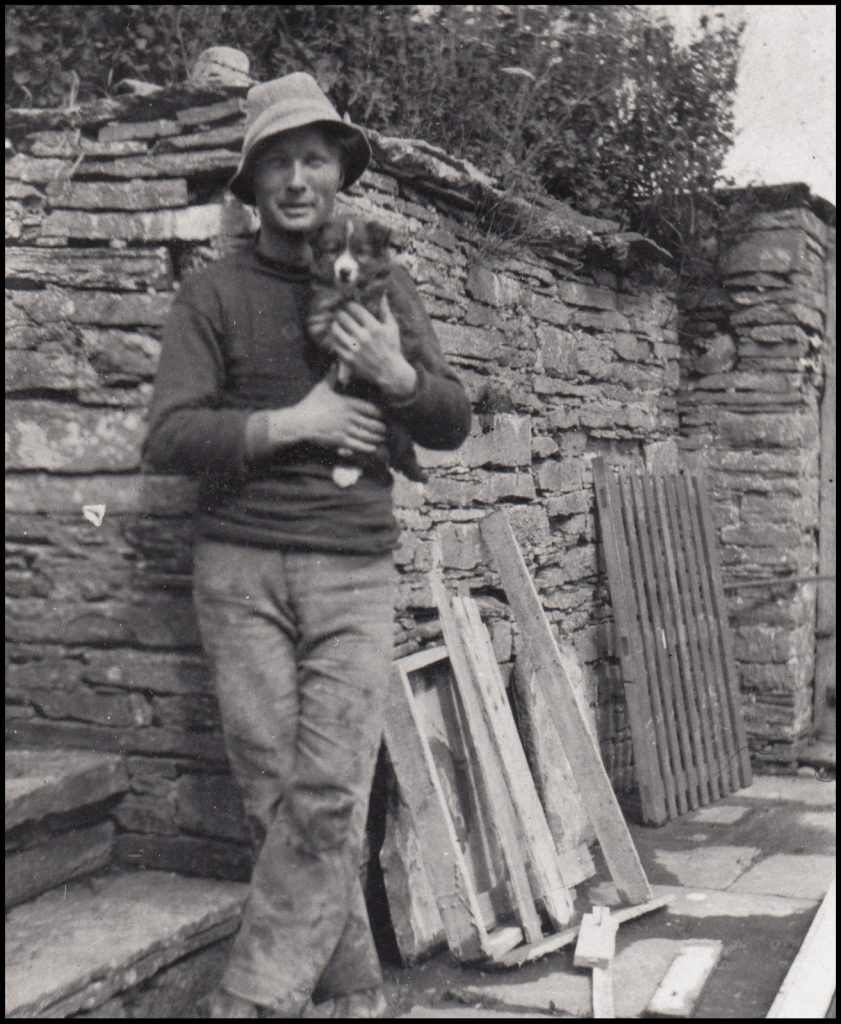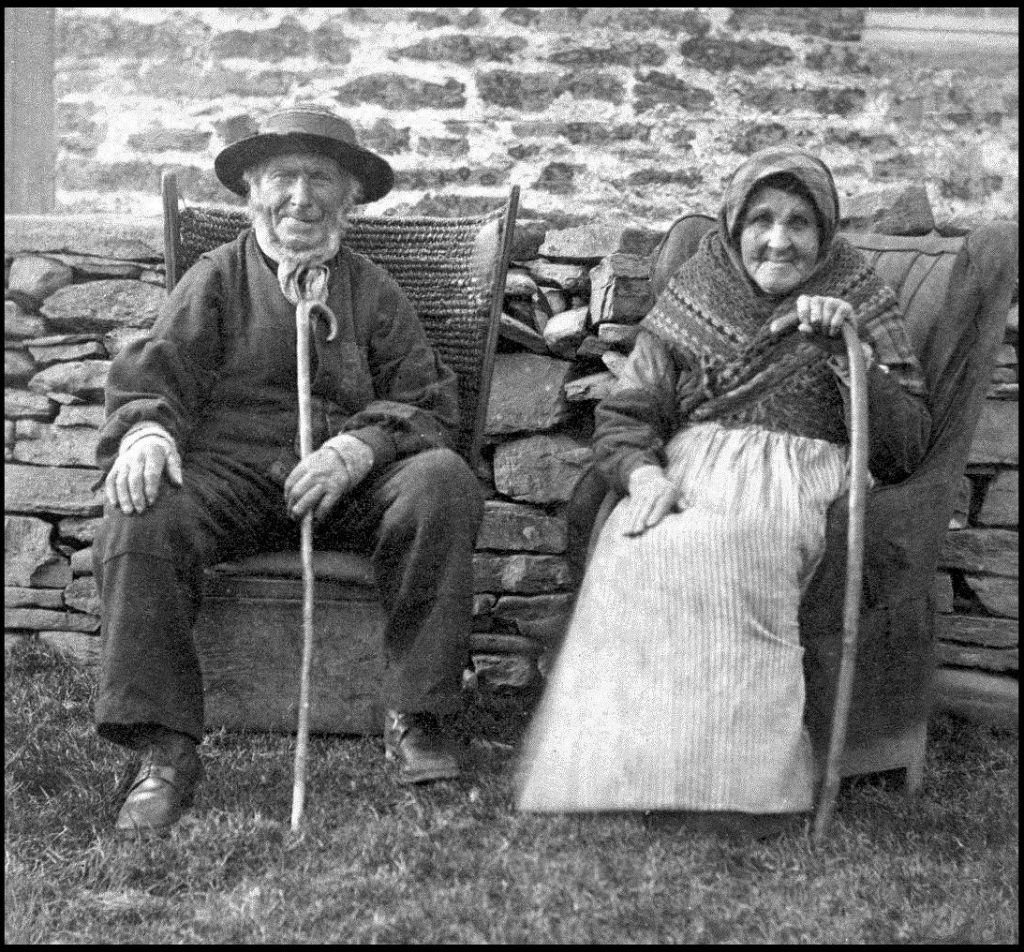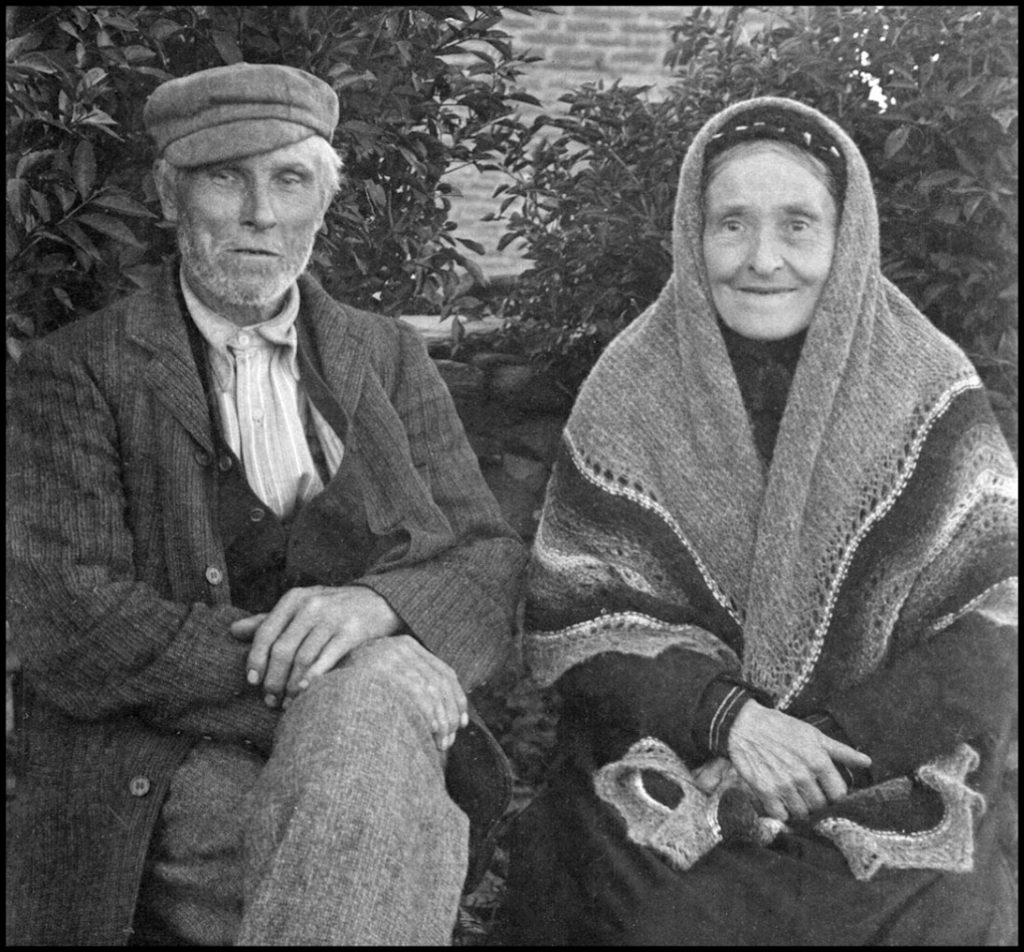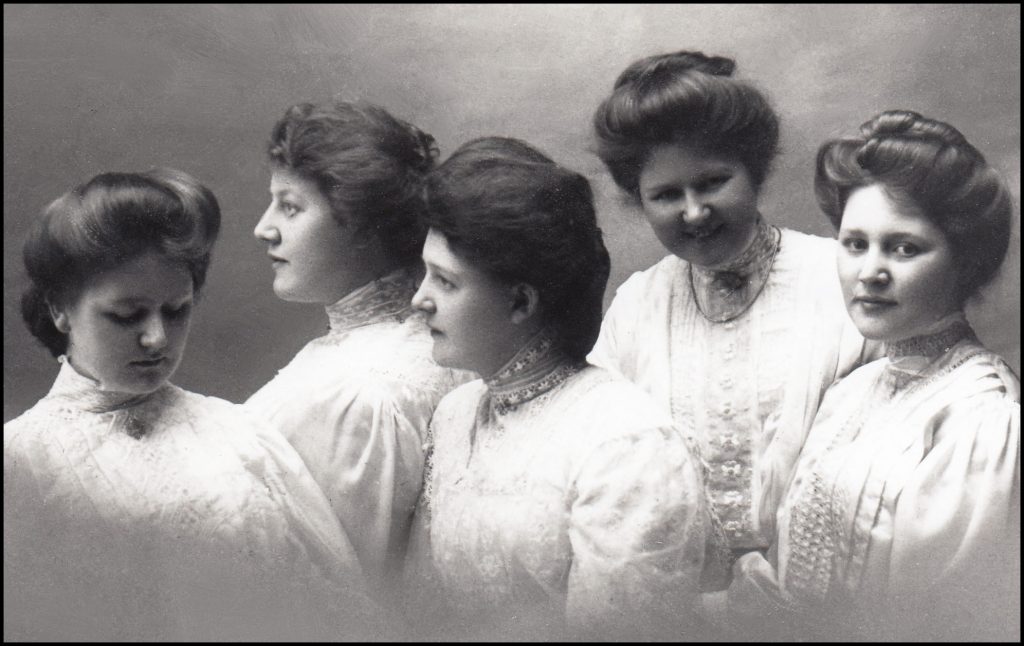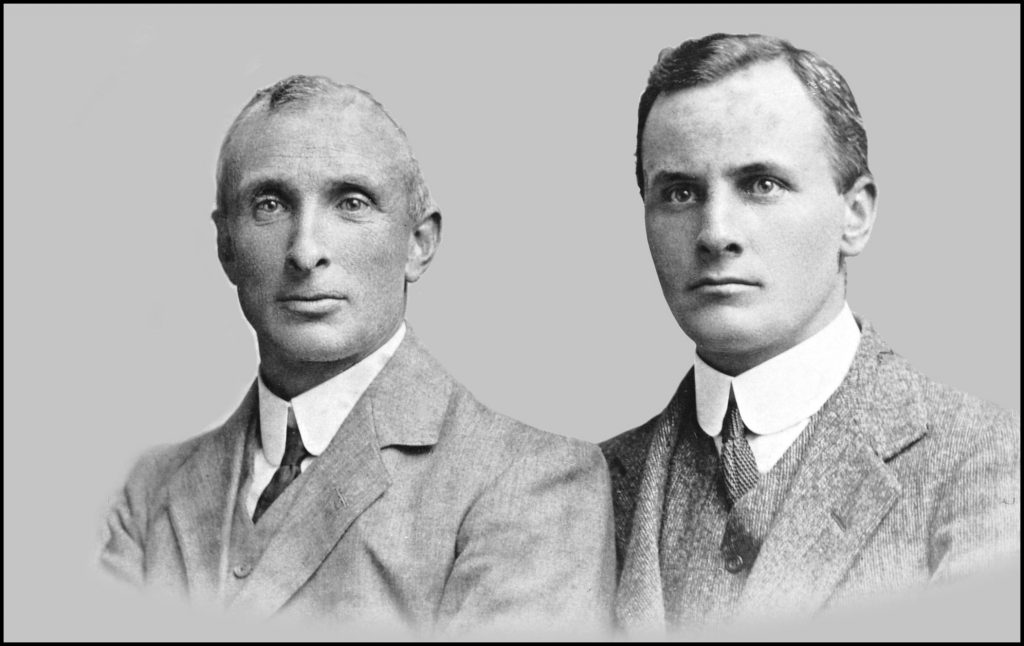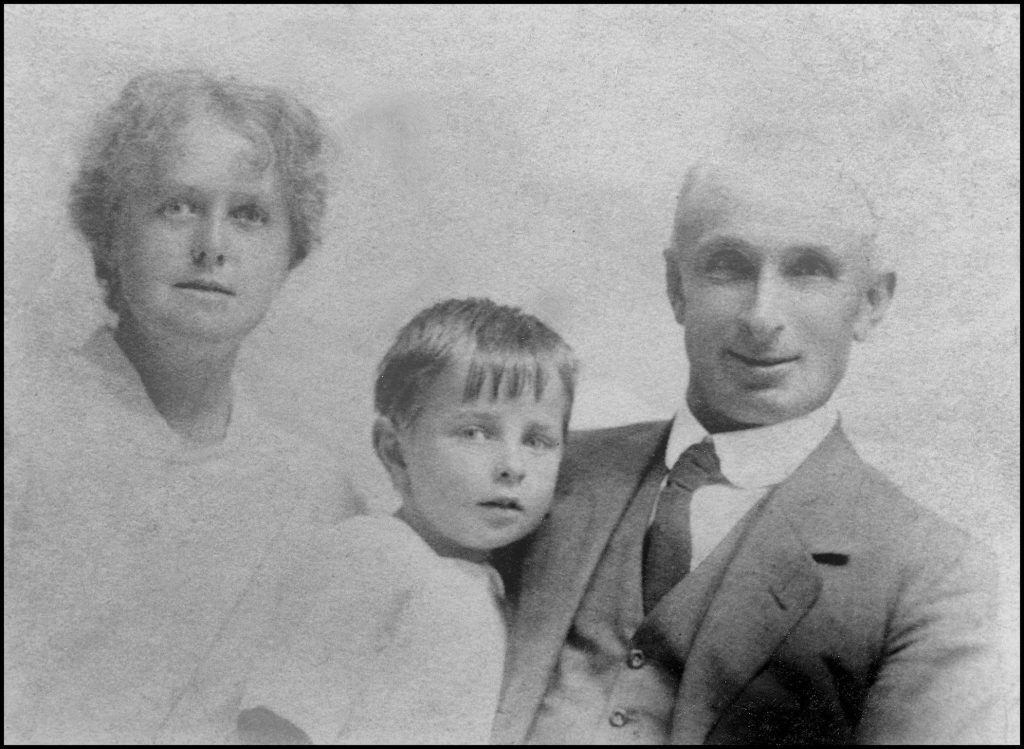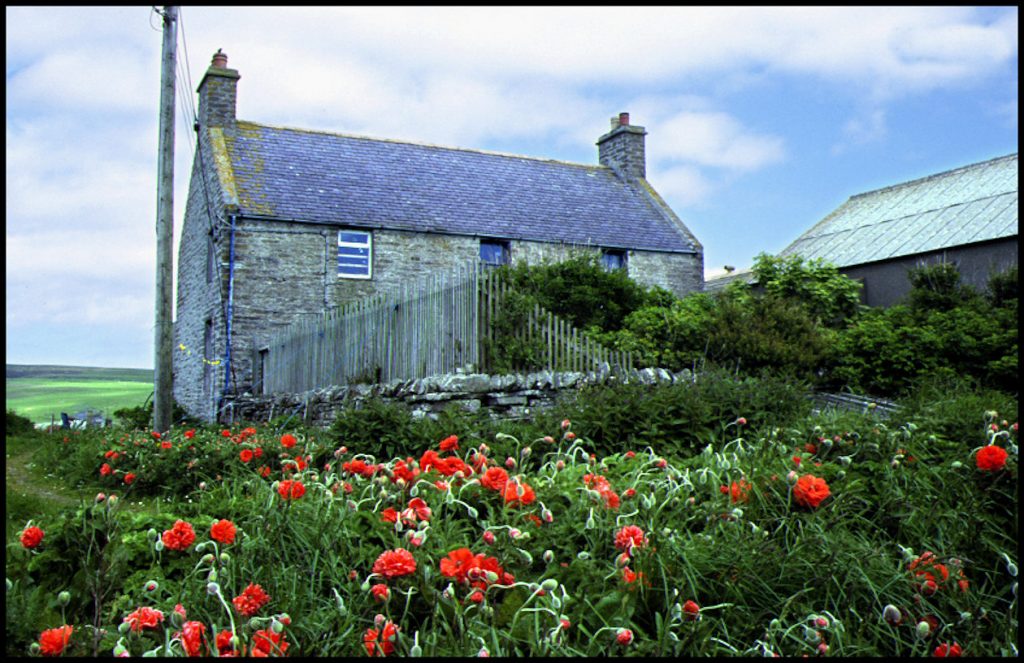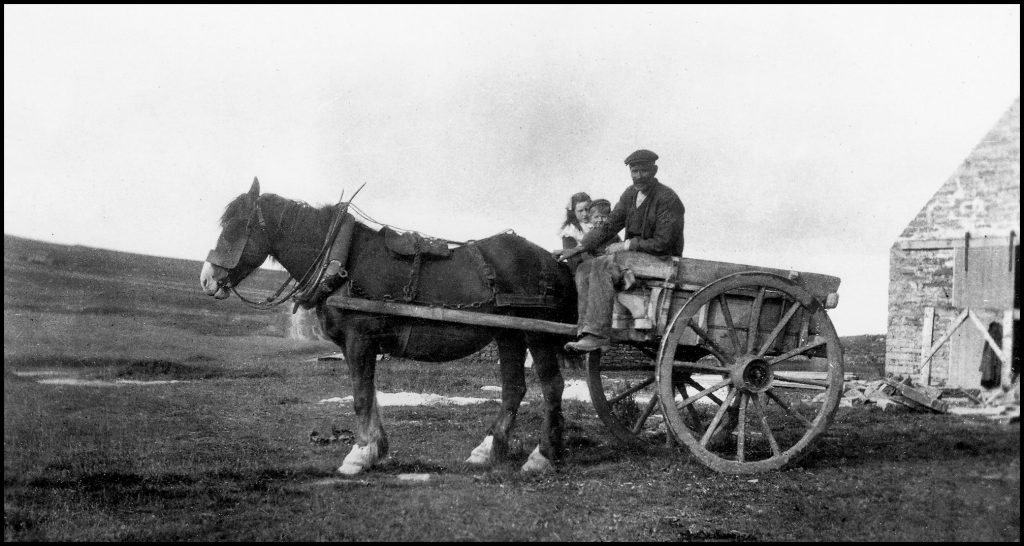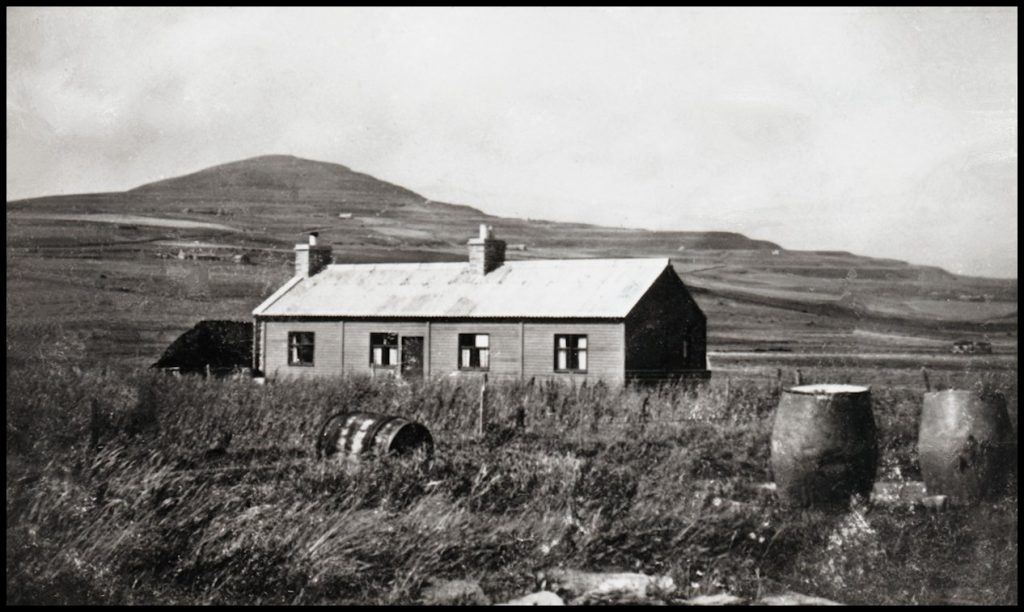Nethermill, Lopness, Guidal, & Hurtiso
Tommy Gibson tells us about the Sourin Mill
The Sourin Mill is a large well-built stone building of three storeys, situated at the end of the Sourin burn near Lopness and Nethermill. This was the largest building in Sourin, and today still stands as straight and square as it was when it was built. On the west end of the building four plaques have the dates of 1777, 1861, 1880, 1937. The first date is presumably when the building was constructed. It is not known if there was a mill there before, and I doubt if there were. The wheel on the east end of the mill is a cast iron construction, and was made in sections. The wheel was 14 feet in diameter, and 4 feet across with 48 buckets. The axel, holding everything up, was 5 inches of solid steel. The arrangement at the wheel for the water was overshot; this was quite a powerful wheel to drive all the equipment, which were three sets of grinding wheels. The first one was for bere meal; the stone was from Derbyshire, called Derby Burr. The oatmeal stone was manufactured; it was made in sections and then banded with iron hoops, called a French Burr. The shelling stone usually came from Yesnaby in Sandwick. Also the hoist; this was to lift the sacks of grain to the top of the mill, and elevators and separators and fans. The water driving the wheel came from the Muckle Water, with a small dam that was built at Woo. A ditch was dug from the dam to the wheel above the burn to the mill course as the wheel was overshot. A wooden trap in the mill course diverted and governed the amount of water to and from the wheel. In the 1940’s a small shed was built at the rear of the mill.
This was a room to house a small dynamo driven by a small water wheel, to provide electric light in the mill. The only light was from paraffin lamps, and this was the only light used since the mill was built. Before the days of the mill, most of the houses had a kiln attached to the barn, which the corn and oats for drying was done. After the mill was built, a lot of drying was still done but then the grain was sent to the mill. This practice was continued up to the 1850’s, then more and more grain sent to the mill undryed. The kiln at the mill became too small, and in 1861 a larger kiln was built. This was slightly wider than the mill and slightly higher. This increased the floor area for grain drying. I have no record for 1880, but there must have been some structural work taken place. In 1937 the kiln took fire. The roof of the kiln was badly damaged and the mill was out of production for a while. Had the fire gone into the main building the whole lot would have been destroyed. There is a tremendous amount of timber in the mill. Heavy beams under the floor, holding up untold tons of grain, huge beams, a foot square holding up the hoist mechanism, which is housed in a wooden structure in front of the mill. Repairs to the kiln and a new roof was put on and the mill started up again.
The miller, or his son or servant, had to walk up to the tepping (sluice) early on a Monday morning to open the sluice as it took a few hours for the water to flow down. This water ran till Saturday when it was closed in the afternoon. The water ran on till 9-10 o’clock when the mill closed for the day. Only in the springtime when the water was not so plentiful that the sluice was closed every afternoon. The miller usually worked for 14 hours a day and six days a week and usually employed a kiln man and at busy times a labourer. On the average working day the mill ground 25 sacks of oats and 22 sacks of corn or bere. A sack of grain was 2 cwt, this was traditionally the correct weight for the mill, and the meal came in how (boll) sacks. A boll was 10 stone.
Corn or bere had only two rows of grain while barley has four. Long ago it was mainly black oats and red sandy; it was only in later years that heavier oats were available. The best yield was from the smaller oats. Products from the mill were oatmeal, bere meal, grapp and souan sids. Grapp was an inferior grade of grain and hull, ground for pig and poultry feed. Souan sids, was when the flour was riddled small bits of husk and the finest flour was gathered up. This was then soaked and made into a sharp porridge. I remember in the mid 1950’s Robbie Seatter of Banks had a square of corn growing in a field above the mill. The area was about half an acre, and this was about the last of the corn grown in Rousay for the Sourin mill.
Each sack of grain weighed 2 cwt. each. This was traditionally the correct weights for the mill. Carts which came to the mill with grain usually went under the hatch in front of the mill. The grain was then lifted to the top of the mill by a hoist. Once the hoist was engaged the sack had to travel to the top of the mill. A chain with a loop was then put around the sack. Once a farmer put the chain around the sack, and unfortunately the hoist was engaged before his fingers were out of the chain. The miller looked down when he heard shouting. “Woe, woe, stop, stop,” the farmer was coming up holding on very, very tightly to the sack! The Sourin mill took most of the grain in Rousay. In the springtime when the weather dried, the Sourin mill had plenty of water and grain came from Westray, Eday, North Fara, Egilshay and Wyre. When the North Fara men came to the mill, they went to Hurtiso for a horse and cart to take the grain from the boat to the mill. Sometimes the horse was working, or in the hill, so they were quite happy with a cart. Fara men were big and strong: they pulled the cart themselves. Three Westray men were drowned near the Clett at Scockness. The boat was a Westray skiff, loaded with grain. Northerly wind and a back tide cause a nasty upheaval in the water along the Clett. The boat, perhaps too close to the shore, missed a tack and capsized at the shore. The mill was a meeting place for local boys from the district of an evening. Some of the more popular ones were going hand-over-hand over the twartbaeks (couple backs) in the roof. Another thing they did was to write their name on a wall using a fifty-six pound weight as a pen, hooked on their little finger and only very few of them could do this. In many ways it is a pity that the mill had to close, for it was a source of food and as a social gathering place in the evening for the people of the district, for news, views, contests and trivia etc. The mill closed down in 1955.
SOURIN MILLERS
The first miller on record in Sourin was Hugh Marwick, born c.1776, and was living at Clumpy in the early 1800s with his wife Janet. His brother William, born c1786, was an ‘under miller’ according to the census of 1841. William, originally of ‘Oot-o-dikes, Sowrine’, was married to Jane Work and they lived at Hanover. They had a family of ten children, born between 1816 and 1838. Son John, born in August 1822, was also a miller, and married to Margaret Costie, daughter of David Costie and Betty Gibson.
The census of 1861 tells of 28-year-old miller William Melville, born in Sanday, living at Lopness with wife Margaret. At this time Robert Harrold was a 40-year-old, miller living at Hammermugly (Blossom). He was married to Mary Grieve, daughter of Alexander and Catherine Grieve, Howe, Egilsay. They had a family of five daughters born between 1855 and 1860, two of whom, Mary and Isabella, were twins.
In 1871, 29-year-old miller William Voy from Tankerness, was living at Lopness. He had recently married Jemima MacLellan Johnston, daughter of John Johnston, Brinian, and Elizabeth Reid, Pow, Westside, who was born in June 1842. They raised a family of seven children between 1869 and 1887.
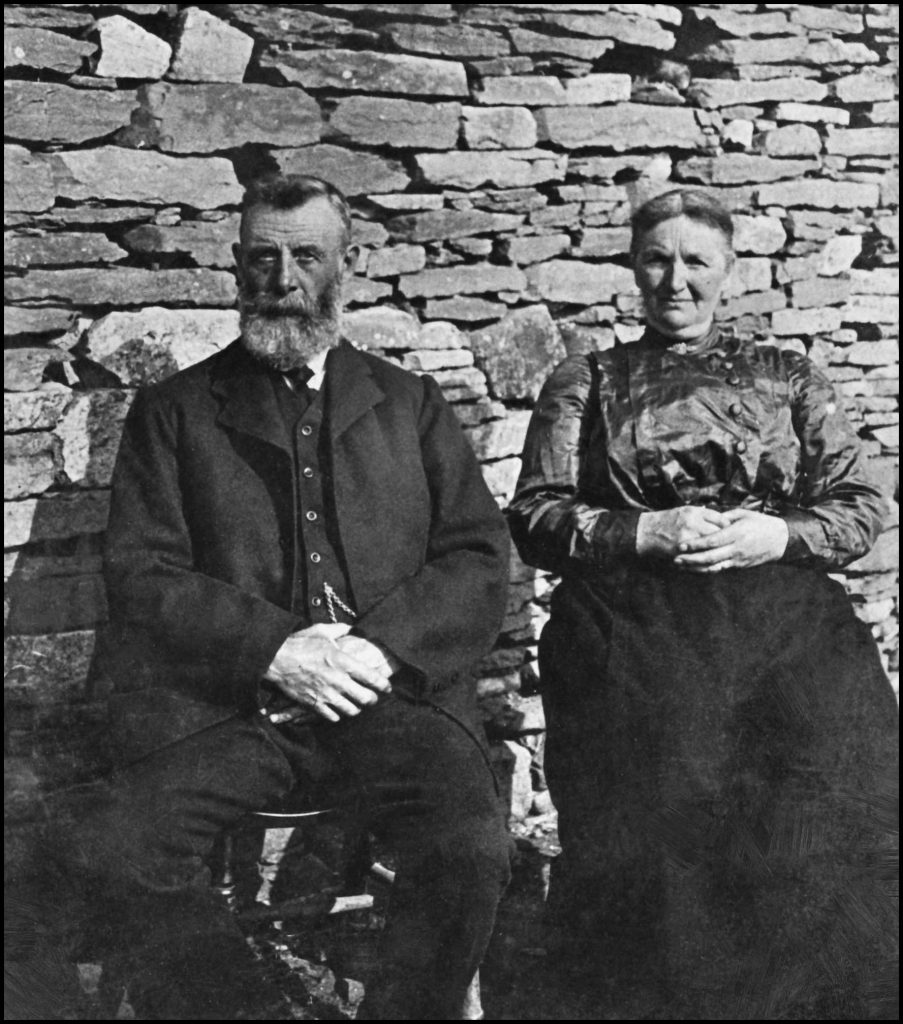
The census of 1881, carried out on April 4th that year, recorded the aptly-named Alexander Miller as the Sourin miller, employing two men – though their names are not mentioned. He was born in Wick c.1850, and was married to Anne Mainland, daughter of John Mainland, Bu, Wyre, later Onzibust, and Mary Sinclair, Tratland, and she was born in November 1854. Alexander and Anne were the parents of four daughters and one son, born between 1876 and 1885.
The 1890s saw farmer/miller John Gibson living at nearby Hurtiso. Born at Sketquoy in January 1839, he was the son of Hugh Gibson and Janet Craigie, Cogar. In 1867 he married Margaret Louttit, daughter of William Louttit and Christina Cormack, Faraclett. They raised a family of eight children, born between 1869 and 1884. Also living at Hurtiso at this time was 35-year-old miller James Wood, who was born in Evie.
John Craigie was the miller at the Sourin mill for many years. The son of John Craigie, Shalter, and Betsy Louttit, Blackhammer, he was born in March 1859. In November 1878 he married Betsy Leonard, daughter of George Leonard, Stourameadow, and Margaret Clouston, Tou, born in November 1857. They lived at Triblo and raised a family of ten children born between 1879 and 1904. After Betsy’s death in 1932 John, along with daughters Isabella and Annie, took over the Queen’s Hotel in Kirkwall.
Sourin Miller John Craigie and his wife Betsy Leonard

NETHERMILL
There are three separate entries for Nethermill in the census of 1841. First occupant was 65-year-old Betsy Sinclair, who made a living from spinning. Then there was 35-year-old Alexander Reid, his wife Mary, who was 25, and their seven-month old daughter Mary. There was a bonnet maker there too, 25-year-old Julia (Giles) Mainland, daughter of Alexander Mainland, Banks, Frotoft, and Margaret Grieve, Hurtiso.
There is an interesting entry in one of the laird’s rent books regarding an inhabitant of Nethermill in 1845, William Inkster – “he poaches the Salmon Trout that come up the burn – must pull this house down.” A new house [pictured below] was built at Nethermill – but not until 1887.
There were two new families in 1851. Living at Nethermill 1 was 30-year-old seamstress Helen Grieve, her 25-year-old sister Mary who was an agricultural labourer, and their 23-year-old brother Alexander, who was a fisherman. These were three of the six children of navy pensioner James Grieve [born c.1776] and Elizabeth Davie. They were all born in Egilsay between 1816 and 1831. Helen, christened Eleanor Bews Grieve, married William Marwick, Hanover in 1852. Alexander married Margaret Harrold, Hammermugly.
At Nethermill 2 was 29-year-old fisherman John Marwick [William’s brother just mentioned], his 29-year-old wife Margaret Costie and their children, Betsy (3) and John, who was twelve months old. John and William were sons of William Marwick and Jean Work of ‘Oot-o-dikes, Sowrine’, and he was born on August 4th 1822. Margaret was the daughter of David Costie and Betty Gibson and she was born at Breek, Quandale, on May 6th 1822.
By 1861 Alexander Grieve and his family were the only inhabitants of Nethermill. His wife Margaret was the daughter of William Harrold and Elizabeth Grieve of Hammermugly, and she was born on August 10th 1818. Their three children were William, born in 1855, Alexander, in 1856, and John Yorston, who was born in 1859. As well as making a living from fishing in the latter years of the 1800s Alexander made ends meet making money as a weaver. Meanwhile, his son Alexander was a dryster – meaning he was in charge of the drying of grain in the kiln at the nearby mill.
[Above left] William McLaughlan Harrold Grieve [born 14 April 1855] and Mary Ann Clouston [born in Orphir, 1868], daughter of John Honeyman Clouston and Catherine Groundwater, were married in Kirkwall on March 28th 1903, witnessed by Maggie Jane Grieve and Archer Clouston. William and Mary Ann later lived at Upper Knarston.
[Centre] Teacher John Yorston Grieve, Nethermill, with his nephew David Marwick [son of Eleanor Bews Grieve and William Marwick, who went to Canada]. John was born on January 26th 1859. He married Anne Gibson Grieve, daughter of Malcolm Grieve and Frances/Fanny Costie, who was born on July 14th 1862. On July 14th 1881 Anne died of a fever during childbirth at the schoolhouse at Pierowall, Westray, where John was the assistant teacher. John died on Oct 28th 1889, aged 30, and they are both interred in the Scockness kirkyard.
[Above right] Alexander [Sandy] Grieve, the dryster mentioned above, born on November 7th 1856, died 1945.

LOPNESS
We have learned already that Lopness [pictured below] was where a succession of Sourin millers lived over the years…..
In 1861 it was occupied by 28-year-old William Melville from Sanday.
In 1871 William Voy, a 29-year-old miller from Tankerness, lived there with his wife Jemima Johnston, daughter of John Johnston and Elizabeth Reid of the Brinian. They were married in 1869 and by the time the census was carried out they had a one-year-old son William.
31-year-old Alexander Miller from Helzigatha, Wyre, a miller employing two men, lived at Lopness in 1881. He was married to Anne Mainland, daughter of John Mainland and Mary Sinclair of the Bu, Wyre, who was born on November 12th 1854, and they had five children.
Above left are sisters Alice and Cissie Craigie, who originally lived at Furse. Alice married Stanley Gibson, Bigland, later Lopness, and Cissie married his brother Hugh. Alice and Stanley had three children, Hugh Inkster, Margaret Gladys, and James William [in the picture – who later married Ruth Miller, Schoolhouse, Wasbister]. c.1934. – To the right is the afore-mentioned Stanley Gibson, son of Alan Corsie Gibson and Jane Agnes Sinclair, who was born at Bigland in 1905. Renowned for his expertise as a stonemason and builder, examples of his work can still be seen around the island to this day. Here Stanley takes a break from work, to pose for the camera with his dog at Viera Lodge, c.1940.

GUIDAL
Guidal was a cottage in Sourin between Hurtiso and Lopness, occupied in 1653 by Alexander Yorston, between 1735 and 1739 by Peter Sinclair, and in 1798 by George Craigie. In the Rousay Birth Registers in the 18th century the house was called Bergoodale, and in 1803 Bergoodal, though from 1816 onwards Guidal.
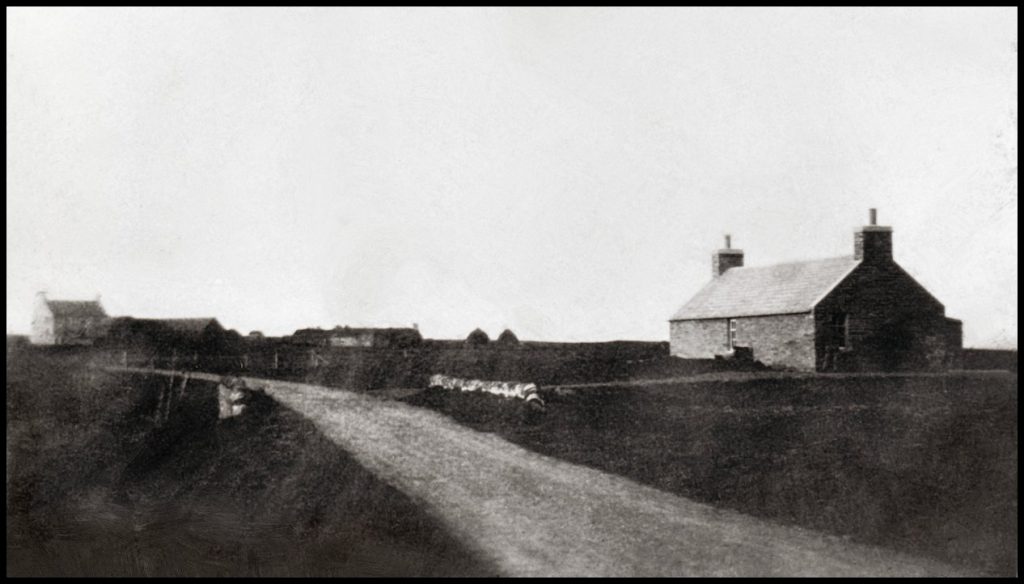

By 1840 shoemaker Isaac Marwick lived at Guidal with his wife Betsy Yorston. Isaac was the son of Hugh Marwick and Betsy Sinclair of Scockness, born on July 26th 1812 – another of Betsy’s “ten devils.” Betsy Yorston was the daughter of Magnus Yorston and Janet Marwick of Oldman, born on February 19th 1812. Married on January 15th 1836, Isaac and Betsy had three children: Hugh was born in May 1840; Isaac Elrick, in June 1844 [he married Mary Crossman Wilson on Holy Island, Northumberland in April 1875, and became a minister in Kirkcaldy]; and Janet, who was born in September 1848. [At the time of the 1871 census she was a teacher at the Sourin school]. Isaac and Betsy lived at Guidal all their lives.
In 1862, son Hugh went to New Zealand with his uncle Thomas. He worked there as a carpenter and boat builder until he returned to Orkney to be married in 1870. His bride, on May 31st that year, was Lydia Gibson of Langskaill, daughter of George Gibson and Ann Mainland, who was born on June 28th 1842.
Isaac and Betsy Marwick at Guidal.
After their marriage Hugh returned to New Zealand with wife Lydia, and their daughter Betsy Ann was born in Otago in 1871. They soon came back to Rousay though, for daughter Janet (Jessie) was born here on November 13th 1872, as were brothers, Isaac, on March 24th 1875, and Hugh, who was born on November 30th 1881. Hugh senior opened a shop at Guidal, but at the same time he carried on his other work of carpentry and boat-building. He was also employed as the island’s School Attendance Officer, and the Registrar of Births, Marriages and Deaths.
The census of 1891 tells us that Betsy and Isaac Marwick [pictured above] were both in their 80th year, and he was still making boots and shoes at Guidal. Son Hugh was a 50-year-old merchant, his sister Jessie was a ‘pupil teacher’, brother Isaac an apprentice shoemaker, and young brother Hugh was a nine-year-old scholar. Jessie Marwick was head teacher at the Sourin school between 1903/1911, and later head of Ely School in Cambridgeshire. Betsy Marwick died at Guidal on January 27th 1900 at the age of 87 and her husband Isaac was 94 when he passed away on December 16th 1906.
Hugh Marwick [born 1881] was educated at Kirkwall Grammar School and Edinburgh University, later becoming head of English at Burnley Grammar School in Lancashire. In July 1914 he married photographer’s assistant Jane Barritt. Born on February 20th 1888, she was the daughter of Burnley councillor Charles Barritt and farmer’s daughter Mary Martha Whittaker, who were married on November 30th 1873. Jane had four sisters: her twin Elizabeth, Ellen, Annie, and Florence Mary. Hugh and Jane has a son, christened Hugh Gibson Marwick, born in 1916. He was just 12 years old when he died in the Balfour Hospital as a result of an accidental fall on January 31st 1928, the family living in King Street, Kirkwall at the time.
Hugh Marwick was appointed Rector of Kirkwall Grammar School in 1914 and continued in that role until 1929, when he was made director of the Orkney Education Committee, a post he held until 1946.
His MA [Master of Arts] was from the University of Edinburgh, who awarded his D.Litt. [Doctor Litterarum, or Doctor of Letters] in 1926 after he had worked many years on his doctoral thesis, the basis for his book The Orkney Norn. Dr Marwick was one of the founders of the Orkney Antiquarian Society in 1922 with fellow Orcadian and Norse enthusiast John Mooney JP, FSA (Scot) and was its secretary for 17 years, during which he contributed papers to its Proceedings. He was also a Fellow of the Society of Antiquaries of Scotland. Dr Marwick received many academic awards for his work both in this country and Scandinavia.
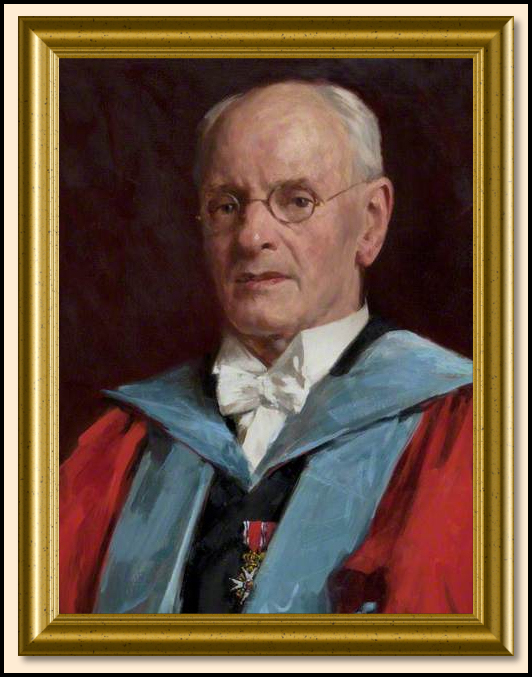
On Wednesday December 15th 1954 he was granted the Freedom of the Burgh of Kirkwall, a ceremony marking the occasion being held in St Magnus Cathedral where he signed the Burgess Roll. He was also an honorary sheriff-substitute for Orkney. He was appointed an Officer of the Order of the British Empire in 1965.
His published works include: The Orkney Norn (1926 University of Edinburgh D.Litt. Thesis, 1929 Oxford University Press); The Place Names of Rousay (1947); Orkney (1951); and Orkney Farm-Names (1952).
Dr Hugh Marwick passed away at noon on May 21st 1965. He is remembered in a memorial plaque in St Magnus Cathedral alongside a number of other ‘sons of Orkney’, including George Mackay Brown, Robert Rendall, Stanley Cursiter, and Edwin Muir.
A photo of a copy of the Stanley Cursiter portrait of
Dr Hugh Marwick, painted to mark his OBE
appointment in 1965. This portrait hangs
in the Rousay Community School.

HURTISO
Hurtiso was an old farm in Sourin, occupied by Thomas Seatter in 1735 and George Craigie in 1798. When Robert Gibson became tenant of Hurtiso the Meal Mill of Sourin, Lopness or the Miller men’s House, and Nethermill or Mill House were included as well, for which he paid an annual rent of £50 in 1845. Robert was the son of David Gibson, Langskaill, and Jean Marwick, and was born in 1799. On March 14th 1826, he married Robina (Bethinia) Irvine, Rendall, and they had ten children, eight girls and two boys.
The Gibson family moved to Langskaill, and by 1851, the 35-acre farm of Hurtiso was in the hands of James Stevenson, a 34-year-old farmer from Stronsay. James was the son of James Stevenson, Stronsay, later Scockness, and Rebekkah Sinclair, and was born in January 1817. On November 27th 1851 he married Margaret Gibson, daughter of James Gibson, Flintersquoy, and Mary Marwick, and she was born in October 1832. They raised a family of eight children between the years 1852 and 1874. In 1853 James paid rent of £80, and by 1872 this had risen to £100.
The Stevenson family moved to Settisgarth, off the Lyde Road in Firth, and by 1881 49-year-old James Marwick was running the farm of Hurtiso. He was the second oldest of the thirteen children of Robert Marwick and Isabel (Bell) Mainland of Essaquoy. Born on September 24th 1831, James was brought up by his uncle and aunt, John and Betsy Marwick, at Ervadale. On March 4th 1856 he married Mary Baikie, the daughter of Peter Baikie and Helen Moar, who was born in Evie in December 1828. James and Mary had five children, all born at Ervadale.
They stayed at Hurtiso for a few years before moving to Bankburn in South Ronaldsay. Their third oldest son was christened George Richie Marwick, after the Rev. George Ritchie, at whose manse Mary had worked prior to her marriage. In the 1881 census 21-year-old George Ritchie Marwick is described as a former apprentice law clerk.
In 1889 John Gibson and his family lived and worked at Hurtiso. In the laird’s words in his rent book he called him a ‘late crofter from Skatequoy’ paying rent of £30 for Hurtiso and £40 for the Meal Mill. John, a farmer and miller, was born in 1839, and was married to Margaret Louttit in 1867 and between 1869 and 1884 they had eight children. They later moved to Faraclett where John died in 1893. A year later the tenants of Hurtiso and the Meal Mill were John Scott and his son from Sanday, paying a combined rent of £82 for the 63 acres arable 18 acres of pasture land.
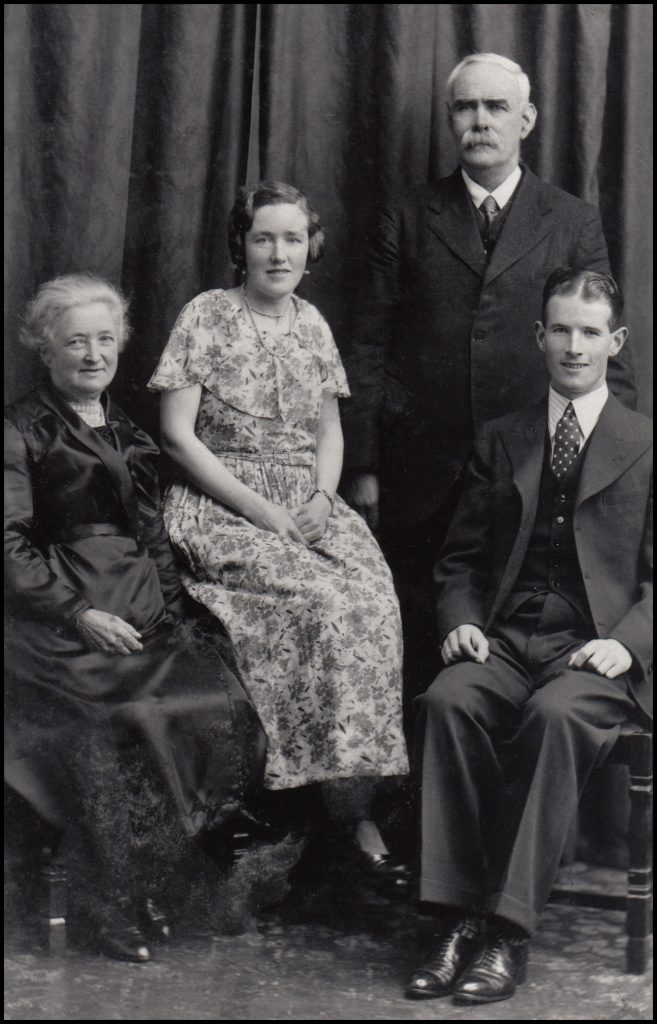
John Scott was the son of farmer John Scott and Janet Dearness of Burness, Sanday, and he was born in 1837. On February 8th 1866 he married Ann Cumming, daughter of stonemason John Cumming and Margaret Mowat, Victoria Street, Kirkwall. They had seven children who were all born at Parlgo, a small cottage in Broughtown, Cross & Burness, Sanday: Margaret Mowat, born on December 7th 1866; John, in December 1868; William Stocks, in August 1871; Annie, in 1876; Jeannie, in 1878; David, in 1882; and Frederick Auty Scott, who was born on November 1st 1885. Margaret was a cook; John helped his father on the farm; Annie was a dairymaid; Jeannie, a general domestic servant; David was a miller; and Fred joined the army. William married dressmaker Jessie Campbell Muir, Clay Loan, Kirkwall, and they lived at Lopness. They had two children: Annie Buchan Cumming, born in 1905, and John Campbell, who was born in 1908. William and his family are pictured to the right.
Later occupants of Hurtiso were the Mainland family. Hugh Mainland [1891-1942], Weyland, Egilsay, Gairsay, later Hurtiso, was married to Alice Gibson Craigie [1891-1991], daughter of James Craigie, Falquoy, and Janet Sinclair, Stennisgorn. Between 1912 and 1928, they raised a family of seven children: Janet Sinclair, Alice Craigie, Margaret (Molly), Hugh, William, Dorothy Margaret, and Clara Cathleen.
Janet married Hugh Grieve, Fa’doon, later Saviskaill; Alice died in 1939, unmarried; Molly married James Craigie, Furse, later Dale, Stromness; Hugh married Kathleen Linklater, Kirkwall, and later lived at Sailan; William married Nessie Alberta (Netta) Russell, Brendale; Dorothy married John Inkster, Cavit, Wyre, and later lived at Old School, Sourin; and Clara died very soon after her birth in 1928.
[All black & white photos courtesy of the Tommy Gibson Collection]
[Map Section: Ordnance Survey 25 inch to the mile, 1st edition, Survey date: 1879,
Publication date: 1880 – [Enhanced for clarity] – ‘Reproduced with the
permission of the National Library of Scotland.’]
